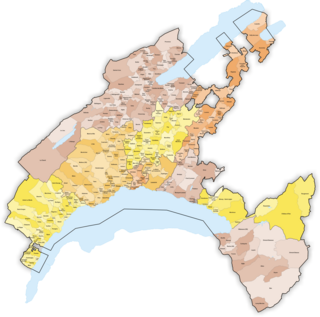
There are 300 municipalities in the canton of Vaud, Switzerland,. Vaud is the canton with the 2nd most municipalities.

The Transports Publics Fribourgeois (TPF) is a renaming of the former Chemins de fer Fribourgeois Gruyère-Fribourg-Morat when the municipal Transport en commun de Fribourg (TF) was absorbed in 2000.
The Chemins de fer fribourgeois Gruyère–Fribourg–Morat (GFM) was a railway company in Switzerland. It was established with the merger in 1942 of two standard gauge and one 1,000 mm gauge railways running mainly within the Swiss canton of Fribourg. It was officially called the Compagnie des Chemins de fer fribourgeois. The company also operated numerous regional buses in the same area. After a merger with Fribourg city transport, the company was renamed Transports publics fribourgeois/Freiburgische Verkehrsbetriebe (TPF).

The Bière–Apples–Morges Railway (BAM) or Chemin de fer Bière-Apples-Morges, located in Switzerland, is a 1,000 mmmetre gauge railway with a total length of almost 30 kilometres (19 mi) which links the towns in its name and from a junction at Apples to the village of L’Isle. The company was renamed to Transports de la région Morges-Bière-Cossonay (MBC) to express its other activities, mainly in local and regional bus services. Furthermore the Funiculaire Cossonay–Gare–Ville is part of MBC since 2010, Before, MBC was contracted to operate it.

The Lausanne-Bern-Fribourg Railway was a former railway company in Switzerland, which was formed in 1858 and absorbed into the Western Swiss Railway in 1872.

The Western Switzerland Railways, were initially a joint operation of three Swiss railway companies, but these companies merged on 1 January 1872. The company was called the Western Switzerland–Simplon Railways from 28 June 1881. The SOS merged with the Bernese Jura Railways to form the Jura–Simplon Railways on 1 January 1890.
The Jura–Simplon Railways (JS), was a railway company that was formed in 1890. It was nationalised in 1903 as the largest railway company in Switzerland and integrated into the Swiss Federal Railways (SBB).
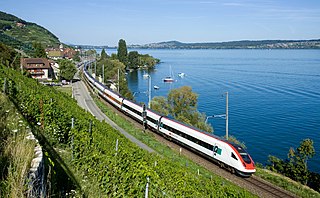
The Jura Foot Line or Jura South Foot Line, is a railway line in Switzerland. It runs from Olten along the foot of the southern Jura range through Solothurn, Grenchen, Biel/Bienne, Neuchâtel, Yverdon-les-Bains and Morges to Lausanne. It is one of two routes used by intercity trains between Geneva and Zürich. The other is the Midland line which connects Olten via Langenthal, Burgdorf, Bern, Fribourg, Lausanne to Morges. The line was built by five railway companies, which after several mergers were absorbed into the Swiss Federal Railways in 1903.
The Geneva–Versoix Railway is a former Swiss railway company that existed officially for only six days in 1858.

Vallorbe railway station is a station at the border of Switzerland and France on the TGV Lyria line between Paris and Lausanne. It is located at the south-eastern entrance of the tunnel which tunnels one of Jura's mountain ranges, Le Mont d’Or. The station serves the municipality of Vallorbe, in the Canton of Vaud, Switzerland.
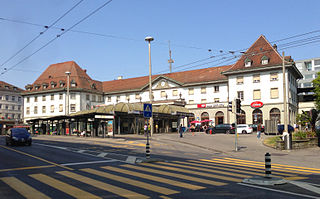
Fribourg/Freiburg railway station serves the municipality of Fribourg, capital of the canton of Fribourg, Switzerland. Opened in 1862, it is owned and operated by SBB-CFF-FFS.

The Simplon Railway is a line that links Lausanne in Switzerland and Domodossola in Italy, via Brig. The 20 km (12 mi)-long Simplon Tunnel is a major part of it. The line between Lausanne and Vallorbe is sometimes considered to form part of the line, making it 233 km (145 mi) long.
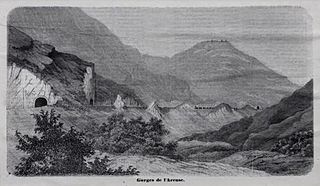
The Franco-Swiss Company was a former railway company in Switzerland, formed in 1859 and absorbed into the Western Swiss Railways in 1872. It built the Neuchâtel-Pontarlier railway.

The Lausanne–Geneva railway is a double-track main railway line in Switzerland. It is an important for passenger transport and is the most frequented railway in Romandy. It serves as an approach from Geneva to the Simplon Railway and the line to Bern and Zürich.

The Lausanne–Bern railway is a mainline railway in Switzerland. The first part of the line was opened in 1860 and the original line was completed on 4 September 1862. The line was built by the Swiss Central Railway and the Lausanne–Fribourg–Bern Railway, which were taken over by the Swiss Federal Railways on its establishment in 1902.

The Palézieux–Lyss railway is a single-track standard-gauge line of the Swiss Federal Railways (SBB) in Romandy.

The Fribourg−Yverdon railway is a single-track standard-gauge line of the Swiss Federal Railways (SBB) in Romandy.
The Fribourg–Ins railway line is a single-track standard-gauge line in Switzerland operated by Transports publics Fribourgeois. It was built by the Chemin de fer Fribourg–Morat–Anet (FMA).
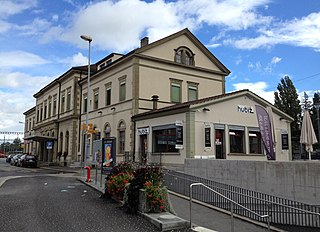
Payerne railway station is a railway station in the municipality of Payerne, in the Swiss canton of Vaud. It is located at the junction of the standard gauge Fribourg–Yverdon and Palézieux–Lyss lines of Swiss Federal Railways.




















